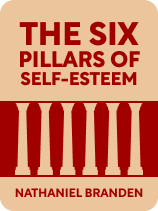

This article is an excerpt from the Shortform book guide to "The Six Pillars of Self-Esteem" by Nathaniel Branden. Shortform has the world's best summaries and analyses of books you should be reading.
Like this article? Sign up for a free trial here .
What does it mean to accept yourself? Why is it important to accept yourself wholly and unconditionally?
Accepting yourself means choosing not to live in conflict with yourself. When you accept yourself, you don’t compare yourself to others to validate your self-worth—you feel worthy the way you are.
Keep reading to learn what accepting yourself entails, why it’s important, and how to accept yourself wholly and unconditionally.
What Is Accepting Yourself?
Psychotherapist Nathaniel Branden posits that accepting yourself is a necessary prerequisite for healthy self-esteem. In his book The Six Pillars of Self-Esteem, he explains how to accept yourself on three different levels.
At the first level of accepting yourself, you’re on your own side. On some fundamental level, you’re born believing that you’re valuable and deserve to exist simply because you’re alive, though some people lose this belief as they age. This primal belief propels us to ask for the help we need and demand the respect we deserve.
(Shortform note: Branden contends that you may lose the conviction that you’re valuable due to your behavior, but success coach Jen Sincero proposes an alternative reason: In You Are A Badass, she argues that we lose our love for ourselves as we age because we absorb messages from those around us that make us stop trusting our instincts and fill us with self-doubt.)
At the second level of accepting yourself, you’re willing to experience all your emotions and behavior—both good and bad. This doesn’t mean you approve of them, just that you don’t deny them. To accept your feelings, Branden explains, use both your body and mind. Breathe deeply to feel the emotion and then take ownership of it—instead of tensing or denying it.
Notably, recognizing your reality isn’t the same as accepting it. For example, you might admit you love someone inappropriate—then immediately move on because you’ve admitted your feelings. This isn’t accepting yourself. You’re not sitting with your reality; you’re avoiding it.
(Shortform note: Like Branden, Brach also stresses the importance of understanding your experience without trying to change it and of always responding with care to whatever you’re experiencing, regardless of whether you’ve erred. Brach adds that if you can’t respond with care—like you might when you recognize but don’t accept your reality—you likely lack the tools to cope with what you’re experiencing, which leads you to judge or blame yourself.)
At the third level of accepting yourself, you treat yourself with kindness. To do this, Branden argues, you accept your poor behavior, then empathetically question why you behaved poorly. (Shortform note: In Nonviolent Communication, psychologist Marshall Rosenberg asserts that poor behavior stems primarily from unmet needs, so he suggests empathetically asking yourself questions like, “What unmet need prompted me to act that way?”)
Finally, Branden recommends, when you inevitably struggle to accept an emotion or behavior, accept yourself by accepting your unwillingness to accept it. If you can’t accept that, accept your unwillingness to accept that unacceptance. Keep going until you reach something you can accept.
(Shortform note: In The Power of Now, spiritual teacher Eckhart Tolle suggests an alternative mental exercise for dealing with things you struggle to accept: Imagine that the irritant has entered your body, and work to break down the “wall” it’s bumping up against so that it can pass through you.)
Exercises to Help You Accept Yourself
Branden recommends a five-week writing program to help you learn to accept yourself.
Follow the instructions listed below every weekday morning and evening. Then, each weekend, review your answers and write six to 10 answers to the following prompt: “If any of what I wrote this week is true, it might be helpful if I…”
Week 1
- Mornings: Create and answer four sentence stems that address what accepting yourself means to you, what happens when you accept or reject your body, and what happens if you accept your conflicts.
- Evenings: Create and answer five sentence stems that address what happens when you reject your conflicts, what happens when you accept or reject your feelings, and what happens when you accept or reject your thoughts.
Week 2
- Mornings: Create and answer three sentence stems that address what happens when you accept or reject your actions and what you are starting to notice.
- Evenings: Create and answer three sentence stems that address what happens when you face the reality of your strengths and shortcomings and what happens when you accept or reject your fears.
Week 3
- Mornings: Create and answer four sentence stems that address what happens when you accept or reject your pain and what happens when you accept or reject your anger.
- Evening: Create and answer four sentence stems that address what happens when you accept or reject your sexuality and what happens when you accept or reject your excitement.
Week 4
- Mornings: Create and answer three sentence stems that address what happens when you accept or reject your joy and what would happen if you were more willing to face your reality.
- Evenings: Create and answer two sentence stems that address what would happen if you were to become more aware of your fears or pain.
Week 5
- Mornings: Create and answer four sentence stems that address what would happen if you were to become more aware of your anger, your sexuality, your excitement, and your joy.
- Evenings: Create and answer three sentence stems that address what happens when you don’t accept yourself, what would happen if you accepted things you didn’t want to admit, and what you’re starting to understand.
| An Alternative Way to Accept Yourself: Build Shame Resilience Practicing “shame resilience” may also improve your ability to accept yourself. In The Gifts of Imperfection, Brown explains that shame is a feeling that you don’t deserve love because you’re not good enough. This feeling compels you to reject and hide parts of yourself that you think others will dislike—just as you do when you cannot accept yourself. However, you can build resilience against this shame by learning to identify shame as it occurs and move past it in a healthy way. Brown implies that you can do so via a four-step process: Step 1: Learn how your shame manifests so that you can identify and address it. You may experience physical sensations, like a dry mouth, or fall into thought patterns, like “I’m not good enough.” Step 2: Identify and evaluate the root cause of your shame. Shame often comes from not meeting certain expectations, so questioning those can build shame resilience. Are they really valid, or are they unrealistic? Step 3: Talk to someone trustworthy about your feelings of shame. If you refuse to talk about your shame, it will fester and consume you. However, its influence over you will diminish if you get the shame out of your mind and into the world, where you and others can address it. Step 4: Avoid unhealthy reactions to shame. Research has shown that we frequently deal with shame in various unhealthy ways, such as by distancing ourselves from or shaming others. None of these approaches to shame will help you to accept yourself. |

———End of Preview———
Like what you just read? Read the rest of the world's best book summary and analysis of Nathaniel Branden's "The Six Pillars of Self-Esteem" at Shortform .
Here's what you'll find in our full The Six Pillars of Self-Esteem summary :
- Exactly how to behave to improve your self-esteem
- Why you need to take responsibility for your life and actions
- Why so many self-esteem techniques don't work






